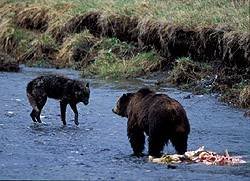
In the year of our Lord, 1215, following years of abuse at the hands of an oppressive monarch, King John "Landlack," the English Lords rebelled. And out of that rebellion came an agreement, the Magna Carta - one of the foundational documents of Western Civilization.
____________________________________________________________
A good portion of the Magna Carta was dedicated to righting wrongs unique to England as it existed in 1215 A.D. under King John. These provisions went to such things as King John's penchant for taking hostages, the removal of several highly unpopular Frenchmen from his administration, and other abuses of now defunct medieval law. But more than a few of the provisions are timeless, establishing the rule by law applicable to all, taxation only with representation, courts to hear complaints, a requirement to show evidence at trial, and trial by jury. For example: 12. No `scutage' or `aid' [a form of tax] may be levied in our kingdom without its general consent . . .
. . .
18. Inquests of novel disseisin, mort d'ancestor, and darrein presentment shall be taken only in their proper county court. We ourselves, or in our absence abroad our chief justice, will send two justices to each county four times a year, and these justices, with four knights of the county elected by the county itself, shall hold the assizes in the county court, on the day and in the place where the court meets.
. . .
38. No bailiff, on his own simple assertion, shall henceforth take any one to his law, without producing faithful witnesses in evidence.
39. No freeman shall be taken, or imprisoned, or disseized, or outlawed, or exiled, or in any way harmed--nor will we go upon or send upon him--save by the lawful judgment of his peers or by the law of the land.
40. To none will we sell, to none deny or delay, right or justice.
You can find the entire document here. Indeed, the rights articulated in the last three quoted paragraphs would shortly thereafter be joined to form the now ancient the Writ of Habeas Corpus - a legal theory very much alive today. In fact, it was the legal theory at the heart of the Supreme Court case of Boumediene v. Bush decided last week.
As I say, one cannot underestimate the importance - nor the modern relevance - of the Magna Carta. It was the Magna Carta signed at Runnymeade that established the idea of inherent rights of individuals to be treated fairly and to be free of government interference except as authorized by law. And as in all such documents, while written in ink, its words were made real by the sword and the blood of those who were willing to sacrifice their lives to fight against tyrany.
The story of how the document came into being is fascinating. And much of that revolves around the defense of Rochester Castle - the first Norman castle built in England on the site of an old Roman fortified town. I will let Brits At Their Best tell the story, but first some background on Rochester Castle built by Gundulf, the Bishop of Rochester, starting in 1087 A.D. for the then exhorbitant sum of 60 pounds ($120).

The Keep of the castle . . . You will note the tower on the left is rounded while the tower on the right, like the two towers not seen, is square. That is because the left one was rebuilt after the seige - and during a time when it was realized that rounded towers provided better defense against seige engines. During the seige by King John, he undermined the leftmost tower by tunnelling under it and destroying the foundation with fire using the fat of 40 pigs. Even with the fall of the tower, the keep was built with an internal cross wall that allowed the defenders to fall back into the other half of the keep, still managing to maintain the defense for several days until starvation and thirst caused them to surrender.

An aerial view of the castle keep and castle grounds. Much of the stone used in the contruction of the walls and battlements came from the old Roman fortifications nearly a millenimum old even then.

A crossbowmans position on the outer battlement walls.

A view from the ground floor looking up into the now empty interior of the castle where wooden floors and great halls once existed.

An engraving of the castle and its moat from a picture taken in 1828.

And lastly, these are the accoutrements of a knight roughly of the era. The above belonged to the Black Prince, an English knight who lived a little over a century after the signing of the Magna Carta.
At any rate, the story is best told by the exceptional blog, Brits At Their Best, who do so in two posts. This from the first post: It took the knights years of misery - and John signing over England to a foreign power, the Pope - before they raised their heads above the parapet. Their first step had been an attempt to reestablish the Charter of Liberties. But John refused to confirm the ancient charter, which upholds the laws of Edward the Confessor and insists that even the king is not above the law. John wrapped himself in the Cross of the Crusader, and hired mercenaries.
After years of disarray, the knights had finally unified, swearing they would stand and act together to uphold the principle of law. When John continued to stall, they took the revolutionary step of renouncing their fealty, and gathering under arms. In May they mustered at Stamford and marched on London. They numbered men as old as Roger Bigod, who was in his seventies, and young men in their twenties. They called their army the Army of God and Holy Church.
When they reached London, Serlo the Mercer, the mayor of London, and all the citizens threw open the gates, and welcomed them. This was unprecedented and vital. It is doubtful that the knight-barons could have carried Magna Carta without the support of the working class people in England's cities and towns. It is incredible that their contribution goes unrecognized today.
Promises of aid poured in from all England, Scotland, and Wales. “There was a moment when John found himself with seven knights at his back and before him a nation in arms”, wrote Green in his Short History of the English People. John’s mercenaries refused to fight.
The knights, city representatives and clergy established the fundamental principles of Magna Carta, and for almost 800 years Magna Carta was held to be an essential part of the British Constitution.
. . . After agreeing to the terms of Magna Carta, John spent a few surly weeks considering his options. Most of the knights dispersed to their homes, but the knights who were supposed to make sure the king lived up to his word suspected the worst and refused to evacuate London. John had delayed the removal of foreign troops from England, as agreed, and was hiring more mercenaries.
By mid-July John had written to his overlord, the Pope, asking him to annul Magna Carta. While he waited for the Pope to reply, he tried to buy off some of the knights. He was able to buy only one.
In September the Pope condemned Magna Carta. He ordered the Archbishop to publicly excommunicate the rebels, and so end their rebellion by rendering their lives and possessions forfeit.
Meanwhile John was moving heaven and earth to recover Rochester Castle from the Archbishop. It may seem odd that an Archbishop of Canterbury would hold a military castle, but it was on such details, and men's willingness to stake their lives on principle, that Magna Carta hinged.
Knowing its vital strategic importance, for three months Stephen Langton refused to surrender Rochester Castle to John; defying the Pope, he refused to excommunicate the knights. The Pope suspended him as Archbishop, and ordered him to Rome. Langton prepared to go, but his resistance had bought the rebels the time they needed.
The war between John and the Magna Carta knights began early in October, 1215, when John bombarded the rebel knights holding Rochester [castle] with huge stone-throwing engines. . .
Read the entire post. And here you will find the second post from Brits At Their Best, detailing in full the fight over the Magna Carta and seige of Rochester Castle. It makes a fascinating read.
As I said earlier, the importance of the Magna Carta to Western civilization cannot be underestimated. The freedoms earned in the Magna Carta were earned by blood and the sword. They will only continue to exist so long as we are willing to defend them with the same.
Read More...
Summary only...























































